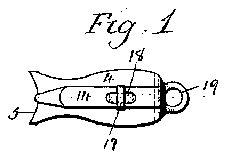
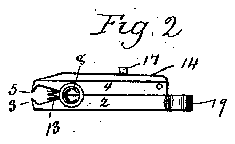
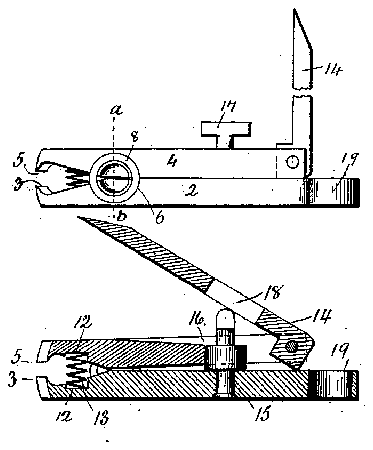
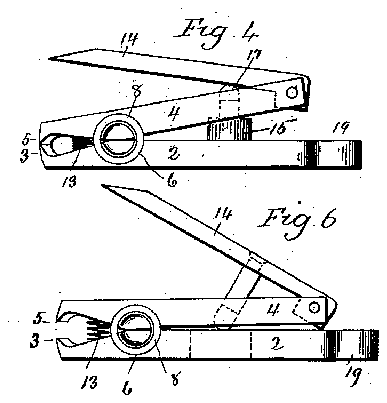
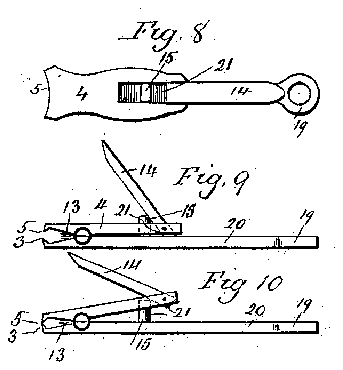
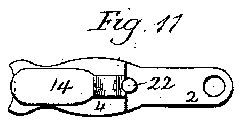
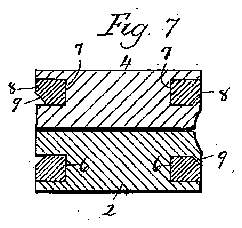
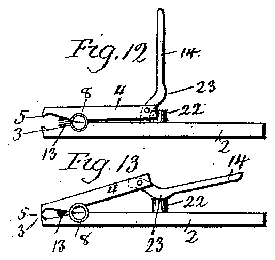
- 2lower plate
- 3cutting edge
- 4upper plate
- 5cutting edge
- 6rming substantially semicircular grooves
- 7corresponding grooves
- 8rings
- 9 forming chambers
- 12chambers
- 13spring
- 14lever
- 15post
- 16slot
- 17head
- 18slot
- 20long tail or handle
- 21short projection
- 22post or fulcrum
- 23shoulder
Description
I PATENTED OCT. 20', 1903. J.. PETRELLI.
FINGER NAIL TRIMMER.
APPLIOATIQN FILED DBO. 8, 1902.
R0 MODEL.
MIR
THE NoRms FETERS co. PHOTO-UTNO" WASHANGTON a r to. that.
Ilatented October 20, 1903 PATENT "OFFICE.
JOSEPH PETRELLI, OF NEW HAVEN, CONNECTICUT.
FINGER-NAIL TRIMMER.
SPECIFICATION forming part of Letters Patent No. 741,709, dated October 20, 1903.
Application filed December 8, 1902. Serial No. 134,257. (No model.)
To all whom it may concern.-
Be it known that I, JOSEPH PETBELLI, of New Haven, in the county of New Haven and State of Connecticut, have invented a new and useful Improvement in Finger- Nail Trimmers; and I do hereby declare the following,
when taken in connection with the accompanying drawings and the letters of reference marked thereon, to be a full, clear, and exact description of the same, and which said drawings constitute part of this specification, and represent, in-
Figure 1, a top View of a nail trimmer constructed in accordance with my invention; Fig. 2, a side viewof the same; Fig. 3, an enlarged sideview with the lever in its open position, the post being turned to permit the lever to be raised; Fig. 4, a side View with the post turned and the lever bearing thereon, showing the jaws closed, as in the cutting operation; Fig. 5, a longitudinal sectional view of the same with thejaws closed. Fig. 6, a modification in the arrangement of the post; Fig. 7, a sectional view on the line a b of Fig. 3; Fig. 8, a top or plan view of a modification of my invention with the lever turn ed to rest upon the face of the extension of the lower plate; Fig. 9, an edge View of the same, showing the lever in its raised position; Fig. 10, an edge view with the lever depressed and the cutting edges together; Fig. 11, a modified form of cutter with the post or fulcrum in rear of the end of the upper plate;
Fig. 12, a side view of the same; Fig. 13, a.
. ing simplicity and rigidity of construction and ease and effectiveness of operation; and the invention consists in the construction, as hereinafter described, and particularly recited in the claims.
In carrying out my invention I employ a fiat plate 2,which for convenience I will hereinafter call the lower plate, this plate being formed at its outer end with a curved cutting edge 3. Connected with this lower plate 2 is an upper plate 4, corresponding in outline to the lower plate 2 and formed at its outer end with a cutting edge 5, corresponding to the cutting edge 3. These plates or cutters are arranged substantially parallel with each other and are preferably united by forming substantially semicircular grooves 6 in opposite edges of the lower plate 2 and corresponding grooves 7 in the upper plate 4. Into these grooves rings 8 are inserted, over the ends of which the edges of the plates within I the ring are turned, so as to hold the rings in their respective grooves, and thereby hinge the two plates together. If desired, and as shown in Fig. 7 of the drawings, the inner outer edges ofthe rings 8.may be beveled,
forming chambers 9, into which the edges of the plates within thering are forced. The inner faces of the plates forward of the rings are formed with chambers 12, which receive the ends of a coiled spring 13,- one function of which is to force-the cuttingedges of the plates apart, and having th e'further function of holding all the parts compactly together when the instrument is folded or closed.
Pivoted to the rear end of the upper plate 4 is a lever 14. To provide a fulcrum for this lever, I preferably mount apost 15 in the lower plate 2, which post projects upward preferably this postis swiveled in the lower plate 2 and provided at its upper end with an oblong head 17, which may project upward through a longitudinally-arranged slot 18 in the lever. When the lever is down upon the upper faceof the upper plate 4, the
through a slot 16 in the upper plate 4, and
head 17 projects above its upper face and may i be turned transversely to the slot 18 and so .as to lock the lever more securely against the face of the upper plate, as shown in Fig. 2. When it is desired to use the cutter, however, the head 17 is turned into line with the slot 18, after which the-lever may be raised to a position at substantially right angles to the upper plate, as shown in Fig. 3. When thus raised, the post 15 may be turned by the head 17 to its former locked positionand so as to form a fulcrum for'the lever when the lever is turned downward, as shown in Fig. 4. Downward pressure upon the lever thus bearing upon head 17 forces the cutting edges of the plates together, as shown in Fig. 4.
Thelower plate 2 may be provided at its Instead of providing the lever with a slot adapting it in its closed position to set over the post the lower plate 2 may be provided with a long tail or handle 20 of any desired form, preferably corresponding in width to the width of the lever 14, and so that the lever when turned backward may rest upon its upper face, against which it will be held by the force of the spring 13, the lever being provided with a short projection 21 at its inner end. Like the construction first described, the fulcrum for the lever is a post projecting upward from the face of the lower plate 2 through the upper plate, and the operation of the lever over this fulcrum is the same as before described. Instead of having the fulcrum or post extend upward through the upper plate 4 it may be arranged as shown in Figs. 11, 12, and 13, in which a post or fulcrum 22 is mounted in the lower plate 2 in rear of the end of the upper plate 4, in which case the lever 14 will be provided with a shoulder 23, which will bear upon the post or fulcrum when the lever is turned backward, the movement of the lever being the reverse of that last described in that in its closed position it is held against the upper face of the upper plate 4 by the action of the spring 13, while in cutting it is moved rearward i11 stead of forward, the action upon the plate 4, however, being the same-that is, the rear end of that plate is raised to force the cutting edges together.
Instead of mounting the post 15 in the lower plate 2 it may be mounted in the lever 14 and so as to extend downward through the two plates, as shown in Fig. 6, the head being adapted to bear upon the upper face of the lower plate when in operative position. It will be clearly apparent that instead of mounting the post or fulcrum in the lower plate or on the lever it may be divided between the two members and the ends arranged to come together in line with each other and operate in the same way as a single post.
The construction shown and described permits the device to be made in very compact and convenient form and readily assembled, thus enabling the production at a very low cost. It is much more rigid and reliable, being made of plates of substantial thickness, than the ordinary thin sheet-metal forms.
Having fully described my invention, what I claim as new, and desire to secure by Letters Patent, is
1. A nail-trimmer comprising a flat upper plate and a fiat lower plate pivotally connected together, normally bearing upon each other throughout their adjacent surfaces and having coacting cutting edges, a lever pivoted to the rear end of the upper plate, and a post arranged to form a fulcrum for the said lever when the same is swung into its operative position, whereby and on account of the flat form and arrangement of the plates, the thickness of the device is reduced to the minimum.
2. A nail-trimmer comprising a flat lower plate and a fiat upper plate superimposed upon the lower plate, the said two plates connected together near their forward ends in planes parallel with each other, said plates formed at their forward ends with cutting edges, a lever pivoted at the rear end of the upper plate, a post or fulcrum between the lever and the lower plate, and a spring between the plates forward of the point of connection and adapted to act both to separate the edges and to hold the lever in its closed position.
3. A nail-trimmer comprising a fiat upper plate and a flat lower plate pivotally connected together,normally bearing upon each other throughout their adjacent surfaces and having coacting cutting edges, a lever pivoted to the rear end of the upper plate, and a post formed independently of and mounted in the lower plate in position to form a fulcrum for the said lever when the same is swung into its operative position, whereby and on account of the flat form and arrangement of the plates the thickness of the device is reduced to the minimum.
4. A nail-trimmer comprising two plates arranged one upon the other, and provided with cutting edges at their outer ends, the sides of the two plates formed with corresponding semicircular grooves, rings inserted into said grooves, and the edges of the plates within the rings turned over the inner edges of the outer ends of said rings, whereby the rings are held in the grooves and the plates thereby hinged together, substantially as described.
5. A nail-trimmer comprising two plates arranged one upon the other and provided with cutting edges at their outer ends, the sides of the two plates formed with corresponding semicircular grooves, rings inserted into said grooves, the inner edges of the out-erends of the rings beveled and the edges of the plates within the rings turned over said bevels, whereby the rings are held in the grooves and the plates thereby hinged together, substantially as described;
6. A nail-trimmer comprising two plates arranged one upon the other, hinged together, and provided at their outer ends with cutting edges, a swiveled post on the lower plate and projecting through the upper plate and form ed with an oblong head, a lever pivoted to the upper plate in rear of said post and formed with a slot in line with said post through which the post extends, the head of the post adapted to be turned over the outer face of the lever when the lever is in the closed position, substantially as described.
In testimony whereof I have signed this specification in the presence of two subscribing witnesses.
JOSEPH PETRELLI.
Witnesses:
FREDERIO O. EARLE, CLARA L. WEED.







